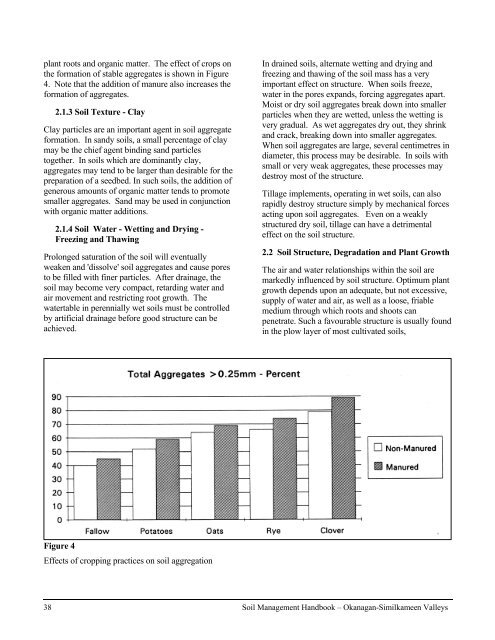Soil Management Handbook - Ministry of Agriculture and Lands
Soil Management Handbook - Ministry of Agriculture and Lands
Soil Management Handbook - Ministry of Agriculture and Lands
Create successful ePaper yourself
Turn your PDF publications into a flip-book with our unique Google optimized e-Paper software.
plant roots <strong>and</strong> organic matter. The effect <strong>of</strong> crops on<br />
the formation <strong>of</strong> stable aggregates is shown in Figure<br />
4. Note that the addition <strong>of</strong> manure also increases the<br />
formation <strong>of</strong> aggregates.<br />
2.1.3 <strong>Soil</strong> Texture - Clay<br />
Clay particles are an important agent in soil aggregate<br />
formation. In s<strong>and</strong>y soils, a small percentage <strong>of</strong> clay<br />
may be the chief agent binding s<strong>and</strong> particles<br />
together. In soils which are dominantly clay,<br />
aggregates may tend to be larger than desirable for the<br />
preparation <strong>of</strong> a seedbed. In such soils, the addition <strong>of</strong><br />
generous amounts <strong>of</strong> organic matter tends to promote<br />
smaller aggregates. S<strong>and</strong> may be used in conjunction<br />
with organic matter additions.<br />
2.1.4 <strong>Soil</strong> Water - Wetting <strong>and</strong> Drying -<br />
Freezing <strong>and</strong> Thawing<br />
Prolonged saturation <strong>of</strong> the soil will eventually<br />
weaken <strong>and</strong> 'dissolve' soil aggregates <strong>and</strong> cause pores<br />
to be filled with finer particles. After drainage, the<br />
soil may become very compact, retarding water <strong>and</strong><br />
air movement <strong>and</strong> restricting root growth. The<br />
watertable in perennially wet soils must be controlled<br />
by artificial drainage before good structure can be<br />
achieved.<br />
Figure 4<br />
Effects <strong>of</strong> cropping practices on soil aggregation<br />
In drained soils, alternate wetting <strong>and</strong> drying <strong>and</strong><br />
freezing <strong>and</strong> thawing <strong>of</strong> the soil mass has a very<br />
important effect on structure. When soils freeze,<br />
water in the pores exp<strong>and</strong>s, forcing aggregates apart.<br />
Moist or dry soil aggregates break down into smaller<br />
particles when they are wetted, unless the wetting is<br />
very gradual. As wet aggregates dry out, they shrink<br />
<strong>and</strong> crack, breaking down into smaller aggregates.<br />
When soil aggregates are large, several centimetres in<br />
diameter, this process may be desirable. In soils with<br />
small or very weak aggregates, these processes may<br />
destroy most <strong>of</strong> the structure.<br />
Tillage implements, operating in wet soils, can also<br />
rapidly destroy structure simply by mechanical forces<br />
acting upon soil aggregates. Even on a weakly<br />
structured dry soil, tillage can have a detrimental<br />
effect on the soil structure.<br />
2.2 <strong>Soil</strong> Structure, Degradation <strong>and</strong> Plant Growth<br />
The air <strong>and</strong> water relationships within the soil are<br />
markedly influenced by soil structure. Optimum plant<br />
growth depends upon an adequate, but not excessive,<br />
supply <strong>of</strong> water <strong>and</strong> air, as well as a loose, friable<br />
medium through which roots <strong>and</strong> shoots can<br />
penetrate. Such a favourable structure is usually found<br />
in the plow layer <strong>of</strong> most cultivated soils,<br />
38 <strong>Soil</strong> <strong>Management</strong> <strong>H<strong>and</strong>book</strong> – Okanagan-Similkameen Valleys
















